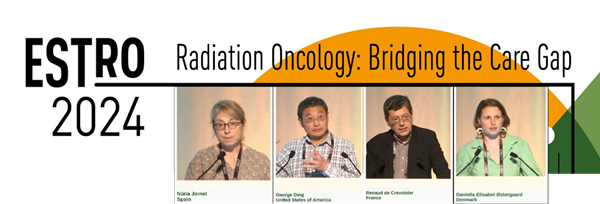Symposium
ESTRO 2024 Congress report
Image-guided radiotherapy (IGRT) plays a crucial role in modern radiation oncology, ensuring precise targeting of tumours while sparing surrounding healthy tissue. IGRT represents a significant advance in radiotherapy, enhancing patient outcomes through improved positioning, precise targeting, and reduced uncertainties from anatomical changes.
Daily kilovoltage (kV) imaging has been a cornerstone of IGRT, as it provides high-resolution images from accurate patient positioning. However, advances in imaging technology and concerns about cumulative radiation dose have prompted a re-evaluation of its routine use. The application of kV imaging requires thorough justification and optimisation, following the principles outlined in the basic safety standard directive. To that end, problems and challenges must be addressed to maximise the benefits of kV-based IGRT procedures while minimising associated risks. This symposium focused on this issue.
The challenges and the modelling of kV and MV IGRT systems were discussed by four experts in the field. Different strategies that could be used to justify the use of and optimise imaging procedures were presented, including adaptive radiotherapy strategies. Finally, clinical applications were highlighted.

During the symposium, Nuria Jornet from Spain delivered an insightful presentation on "IGRT: Current Problems and Potential Solutions". She underlined the importance of determining the timing of imaging within the radiation therapy patient pathway, noting an increasing trend in its use during treatment. Dr Jornet highlighted the advantages of kV-based IGRT, such as enhanced delineation of targets and OARs, improved calculation accuracy and better positional accuracy, which collectively contribute to reduced margins and integral doses. She emphasised the need for a thorough evaluation of IGRT protocols to minimise risks and maximise benefits. She advocated adherence to the principles of justification, optimisation, and dose limits. Despite these benefits, Dr Jornet raised concerns about the additional radiation doses from kV imaging, calling for a critical review of protocols to optimise imaging use and minimise unnecessary exposure in compliance with safety standards. She identified several challenges, including increased imaging doses, resource intensity, unclear tolerance limits, doses to normal tissues, lack of decision support algorithms, insufficient investment in low-dose imaging technology, inadequate training, and insufficient recording of imaging doses. Addressing these challenges is essential for the safe and effective implementation of IGRT in clinical practice.
The second presentation was given by George Ding from the USA, who focused on "Description and Modelling of IGRT Systems". Dr Ding emphasised the need to model IGRT systems due to differences between imaging and therapeutic beams. He discussed how to model kV beams, validate the accuracy of these models, and calculate doses using simulated beams. He highlighted the importance of understanding the characteristics of radiation beams that are used in imaging to determine accurately the radiation dose to patients from imaging procedures. Since dose calculation from kV beams is not typically available in commercial treatment planning systems, Monte Carlo simulations provide crucial insights for reducing imaging doses. He explained that modelling the X-ray source accurately required detailed knowledge of the X-ray tube and filters, and that these models had to be validated through measurements. Dr Ding concluded that modelling X-ray sources and calculating patient doses were both essential to reduce imaging doses significantly in IGRT.
In the third presentation, Renaud de Crevoisier from France delivered an insightful talk on "Justification of IGRT". He highlighted several key points on evaluation criteria for IGRT, including geometrical, dosimetric, predicted and observed clinical endpoints. He showed evidence for the use of daily CBCT-guided IGRT to reduce late toxicity and improve the treatment outcome in prostate cancer patients. Furthermore, he discussed the use of automatic segmentation for plan-of-the-day selection in CBCT, emphasising the dosimetry benefits of ART in cervical cancer using online replanning. He also addressed deep learning-based segmentation in prostate radiation therapy with Monte Carlo-simulated CBCT. Dr De Crevoisier elaborated on the impact of elastic registration methods for dose accumulation and evaluated methods for synthetic CT generation. Finally, he justified the use of CBCT-guided IGRT/ART because of its geometrical and dosimetric benefits, but stated that it lacked positive phase-III trials.
In the fourth presentation, Daniella Ostergaard from Denmark spoke on the "Optimisation of IGRT". She emphasised the vital role of IGRT in treatment precision, particularly in advanced techniques such as ART. With increasing patient lifespans, the need for re-irradiation in overlapping anatomical areas increases, and this issue highlights the need for careful image guidance and adherence to the as-low-as-reasonably-achievable principle to minimise radiation exposure. Dr Ostergaard highlighted the complexity of optimising IGRT, as parameters such as quantum noise, dose, and picture quality must be balanced, and how to address challenges such as patient size and organ movement. She suggested systematic assessment, potentially with deep learning and AI, to tackle these challenges, emphasising the need to tailor optimisation to clinical context and treatment goals. Overall, she underscored the multidisciplinary nature of this task, crucial for adapting to anatomical changes and re-irradiation, and stressed the importance of seamless integration into the clinical workflow.
The conference served as a significant milestone for radiation therapy professionals, offering an enriching academic experience. Attendees delved into various topics, including the evolving roles of RTTs, advances in practice and education, and their crucial role in treatment planning, simulation, patient position and immobilisation, and dosimetry. Throughout the event, participants benefited from teaching lectures, panel discussions, and symposiums that covered topics such as the evolving roles of RTTs and advances in practice. Interactive sessions such as pitch sessions and mini-oral presentations sparked dynamic exchanges of ideas, while poster discussions and proffered papers showcased cutting-edge research. Award lectures recognised outstanding contributions, and joint symposiums facilitated collaboration across disciplines. A highlight was the lively debate sessions, which stimulated critical thinking and dialogue. Additionally, the (online) meeting of the ESTRO P&I focus group was the next step to bring the group forward.
The knowledge and insights gained during the event are invaluable, paving the way for further professional growth and collaboration. Looking ahead, the momentum generated will carry forward into future congresses and foster continued development within the RTT community. The next ESTRO Congress, slated for August 23-25, 2024, in Kuala Lumpur, Malaysia, promises to sustain this positive trajectory.

Prakash Umbarkar M.Sc. Physics, (PGDRTT)
Executive sr. radiation therapist
P.D Hinduja Hospital Mumbai, India
umbarkarprakash@gmail.com
ESTRO P&I focus group

Mirjam Mast PhD
Staff member R&D
The Hague, The Netherlands
Chair: ESTRO P&I focus group